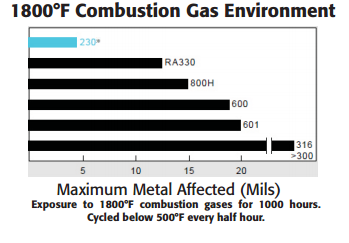HAYNES® 230® alloy for High Strength Furnace Components Tech Brief
High Strength Furnace Components That Last
Chains and belts that stretch and break, retorts and furnace grates that sag and oxidized away, thermocouple protection systems that droop, lances and nozzles that burn-up – maintenance and replacement costs that can eat into your profits.
It doesn’t have to be that way! Furnace components made using HAYNES® 230® alloy have the strength and environmental resistance to stand up under severe service conditions for the long haul, even up to 2100°F (1149°C). And, when it does come time to straighten it or weld-repair it – go ahead! 230® alloy doesn’t get brittle in service, so you can fix it and put it right back in service when you’d be throwing components made of other materials on the junk pile. For nitriding facilities, combustion gas environments, and many other difficult situations where the stress is high and the “heat is on”, 230® alloy can keep maintenance and downtime costs to a minimum.


Hydrogen Embrittlement – Not susceptible
| Nitrogen Absorption in 1200°F (1149°C) Flowing Ammonia After 168 Hours | |
| Alloy |
Nitrogen Absorption (mg/cm2) |
| 230® | 0.7 |
| 600 | 0.8 |
| 601 | 1.1 |
| X | 1.7 |
| 800H | 4.3 |
| 316 | 6.9 |
| 310 | 7.4 |
| 304 | 9.7 |
Nominal Composition
| Nickel | Balance |
| Cobalt | 5 max. |
| Chromium | 22 |
| Molybdenum | 2 |
| Tungsten | 14 |
| Iron | 3 max. |
| Silicon | 0.4 |
| Manganese | 0.5 |
| Carbon | 0.10 |
| Aluminum | 0.3 |
| Boron | 0.015 max. |
| Lanthanum | 0.02 |
Typical Tensile Properties, Plate
| Test Temperature | 0.2% Yield Strength | Ultimate Tensile Strength | Elongation 2 in. (51 mm) | |||
| °F | °C | ksi | MPa | ksi | MPa | % |
| RT | RT | 57 | 395 | 125 | 860 | 50 |
| 1000 | 540 | 40 | 275 | 103 | 705 | 53 |
| 1200 | 650 | 40 | 275 | 98 | 675 | 55 |
| 1400 | 760 | 42 | 275 | 88 | 605 | 53 |
| 1600 | 870 | 37 | 255 | 63 | 435 | 65 |
| 1800 | 980 | 21 | 145 | 35 | 240 | 83 |
| 2000 | 1095 | 11 | 76 | 20 | 140 | 83 |
| 2100 | 1150 | 7 | 47 | 13 | 91 | 106 |
| 2200 | 1205 | 4 | 30 | 9 | 65 | 109 |
Typical Rupture Properties, Plate
| Test Temperature | Typical Rupture Properties: Stress Required to Produce Rupture in Hours Shown | ||||||
| 100 h | 1,000 h | 10,000 h | |||||
| °F | °C | ksi | MPa | ksi | MPa | ksi | MPa |
| 1200 | 650 | 56.0 | 385 | 42.5 | 295 | 29.0 | 200 |
| 1400 | 760 | 27.0 | 185 | 20.0 | 140 | 14.2 | 98 |
| 1600 | 870 | 13.7 | 95 | 9.5 | 66 | 6.2 | 43 |
| 1800 | 980 | 6.0 | 41 | 3.0 | 21 | 1.6 | 11 |
| 1900 | 1040 | 3.5 | 24 | 1.8 | 12 | – | – |
| 2000 | 1095 | 2.1 | 14 | 1.0 | 7 | – | – |
| 2100 | 1150 | 1.2 | 8 | 0.6 | 4 | – | – |
| Physical Property | British Units | Metric Units |
| Density |
0.324 lb/in3 |
8.97 g/cm3 |
| Electrical Resistivity | 49.2 µohm-in | 125 µohm-cm |
| Modulus of Elasticity |
30.6 x 106 psi |
211 GPA |
| Thermal Conductivity |
62 Btu-in/ft2-h-°F |
8.9 W/m-°C |
| Specific Heat | 0.095 Btu/lb-°F | 397 J/Kg-°C |
Environmental Resistance: Flowing Ammonia After 168 Hours
Oxidation in Air – Excellent at 2100°F (1150°C)
Sulfidation – Equal to alloy X
Carburization – Equal to alloy X
Nitriding – Best commercial alloy
Chlorination – Equal to alloy 625
Product Description
HAYNES® 230® alloy is a top-of-the-line high-performance, industrial heat-resistant alloy for applications demanding high strength as well as resistance to environment. It is a substantial upgrade in performance capabilities from common iron-nickel-chromium and nickel-chromium alloys, and displays the best combination of strength, stability, environmental resistance, and fabricability of any commercial nickel-base alloy. HAYNES® 230® alloy can be utilized at temperatures as high as 2100°F (1150°C) for continuous service. Its resistance to oxidation, combustion environments, and nitriding recommends it highly for applications such as nitric acid catalyst grids, high-temperature bellows, industrial furnace fixtures and hardware, strand annealing tubes, thermocouple protection tubes, and many more.

 en
en